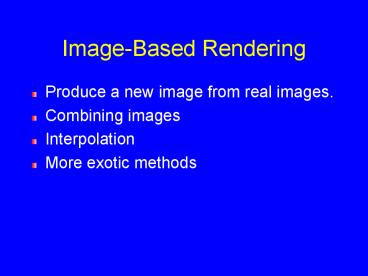ImageBased Rendering - PowerPoint PPT Presentation
1 / 30
Title:
ImageBased Rendering
Description:
Correspondences needed to sensibly combine images. If viewpoint has changed this can be hard. ... (Images in paper by Szeliski and Shum, linked to on web page) ... – PowerPoint PPT presentation
Number of Views:52
Avg rating:3.0/5.0
Title: ImageBased Rendering
1
Image-Based Rendering
- Produce a new image from real images.
- Combining images
- Interpolation
- More exotic methods
2
Why Image-Based Rendering?
- Whats the most realistic image? A photograph.
- But photographs lack flexibility.
- Cant change viewpoint.
- Cant change lighting.
3
The need for correspondence
- Image-based rendering is mostly combining images
to get a new image. - Correspondences needed to sensibly combine
images. - If viewpoint has changed this can be hard.
- If not, its trivial.
4
How to get correspondences
- By hand
- Works if few correspondences needed
- By matching intensities
- This is really ½ of computer vision.
5
Matching
- Simplest SSD with windows.
- Windows needed because pixels not informative
enough. - Compare windows
- Search for windows that match well
6
Mosaics
- Take multiple images and construct one big image.
- Represented as image, cylinder or sphere.
- Allows panning and zooming.
- Simplest kind of motion.
7
- Fixed focal point.
- Correspondence needed to align images.
- Image rectification
8
(Images in paper by Szeliski and Shum, linked to
on web page)
9
(Images in paper by Szeliski and Shum, linked to
on web page)
10
(Images in paper by Szeliski and Shum, linked to
on web page)
11
Other mosaicing issues
- Pixel interpolation needed.
- Mosaicing can provide more information at each
pixel. - Higher resolution images possible.
- Higher dynamic range.
12
Morphing
- What happens if you interpolate images?
- Need corresponding points.
13
Morphing
- Corresponding points needed.
- Often done by hand.
- Interpolate each point.
- Position
- and intensity.
- Also use interpolation for more correspondences.
14
Linear Interpolationof Position
15
Other Interpolation
- Also interpolate intensities.
- Interpolate to find other point correspondes.
16
(Images from Marc Levoys slides
http//graphics.stanford.edu/papers/light/)
Light Field Rendering (Levoy and Hanrahan paper
and slides)
17
(Images from Marc Levoys slides
http//graphics.stanford.edu/papers/light/)
Light Field Rendering (Levoy and Hanrahan paper
and slides)
18
(Images from Marc Levoys slides
http//graphics.stanford.edu/papers/light/)
Light Field Rendering (Levoy and Hanrahan paper
and slides)
19
(Images from Marc Levoys slides
http//graphics.stanford.edu/papers/light/)
Light Field Rendering (Levoy and Hanrahan paper
and slides)
20
(Images from Marc Levoys slides
http//graphics.stanford.edu/papers/light/)
Light Field Rendering (Levoy and Hanrahan paper
and slides)
21
Interpolation
- We have possibly non-uniform samples of a 4D
space. - Must interpolate to fill in.
- Worry about aliasing
22
(Images from Marc Levoys slides
http//graphics.stanford.edu/papers/light/)
Light Field Rendering (Levoy and Hanrahan paper
and slides)
23
Linear basis for lighting
lZ
lY
lX
Surface normal (X,Y,Z) albedo
l Directional source (Lx,Ly,Lz) I
l(Lx,Ly,Lz)(X,Y,Z) LxlX LylY Lz l Z Take
Max of this and 0
24
Using Linear Basis for Rendering
- Render three images
- Take linear combinations.
- Why cant we do this with three real images?
25
Reflectance smooths lighting
26
Basis from diffuse lighting
l
lZ
lY
lX
lXZ
lYZ
lXY
27
- Note, this can also be done with 9 real images,
because this is a basis that contains real images - In 3D, real images arent in the 3D space, we
have to take the max with 0 to get real images.
28
Non-Photorealistic Rendering
- Take a photo and turn it into a different kind of
image.
29
De Carlo and Santella
Video
30
Image Analogies
(Pictures from image analogies paper linked to on
class web page).
Given A, A and B, generate B A bit like Efros
and Leung texture synthesis.

